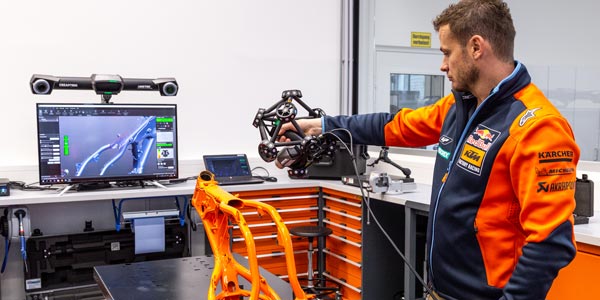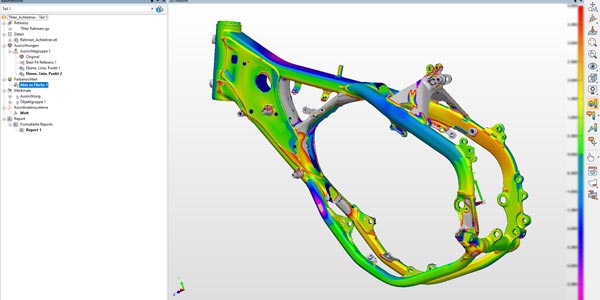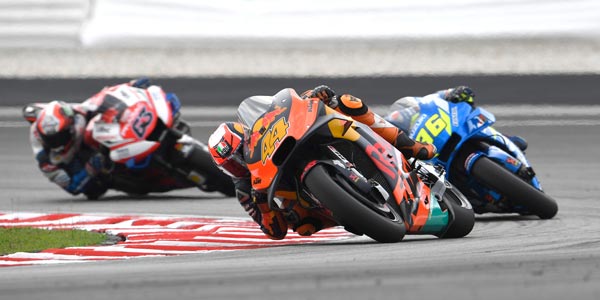Exit this form
Are you sure you want to quit this form?
Building high-performance motorcycles requires race-proven parts controlled by state-of-the-art technologies that enable riders to enjoy a thrilling experience.
Building sport motorcycles for racing requires attention to detail. Designers and engineers have to choose premium materials and produce different geometrical parts with tight tolerances. A scan of the whole bike is essential for certifying that everything fits together. However, sport motorcycles are built to withstand extreme conditions and to be pushed to the limit on the racetrack. Inevitably, the part parameters change and undergo deviations during a race. Therefore, the testing team must be able to measure these deviations directly on the track and not only when the bike is parked in the factory.
Inspecting parts of various shapes and complexity necessitates a 3D measurement technology that can acquire a lot of data without surface preparation. Unlike touch probing, 3D scanning provides an overall view of the inspected part, not just discrete points.
Wear and crash analysis of the frame and chassis are obtained with a scan-to-CAD comparison, from individual components up to the complete vehicle. To do so, the quality control team scans the whole bike and puts the parts in STL data in order to compare them with the CAD files. Therefore, the scanning tool and software suite must be easy to understand and use, without the need for extensive training. Plug-and-play tools and user-friendly interfaces facilitate engineers’ understanding and help them discover improvements that they can add to the design.


Finding the root cause of observed deviations between laps, after racing, and after failures is the quality controller’s responsibility. In the motorsport environment, where speed is proof of everything, measurements must be obtained quickly in order to make hypotheses and draw conclusions. Therefore, the testing team needs a scanning solution that can measure the deviations directly on the racetrack and provide them with accurate data as fast as the bike is racing (or quickly, at the very least).
KTM AG designs, develops, and builds high-performance street and offroad sport motorcycles. Over the years, KTM has built a reputation as a fierce competitor on racetracks around the world. With an established presence in the offroad segments, KTM has progressed to become one of the world’s most innovative manufacturers of street motorcycles and now aims to be the world’s biggest manufacturer of sport motorcycles.
Since KTM’s entire sport motorcycle line is built using premium components, the quality management team requires accurate metrology equipment that can be used either at the factory or on the racetrack. “For us, accuracy is the most important thing,” says Christian Schwarz, Quality Controller Motorsports at KTM AG. It’s one of the reasons they have chosen the MetraSCAN 3D for testing the different parts of the motorcycles. “It is very portable to bring it wherever you want,” he adds, satisfied with his decision.
In addition, the selection of Creaform’s 3D scanning solutions improved communication between the design, manufacturing, and quality control teams. Now, data can be exchanged easily. Closer networking occurs around 3D scanning, and it brings dynamics to the group. All teams can use scanned data and work together from the same information.

Accuracy is provided by precise, high-resolution, and repeatable results, regardless of the measurement setup quality, environmental instabilities, or user experience. For quality control teams, accuracy is usually the most important factor for selecting metrology instruments.
Speed is defined as the capability to generate real-time mesh that is already lightened and processed and ready to be seamlessly integrated into the preferred CAD software.
Portability is made possible thanks to dynamic referencing, where both the part and the instrument can move freely during the measurement process. This way, 3D scanning can be done at the factory, in the quality control lab, or on the racetrack, without affecting performance.
Versatility is demonstrated by the measurement of a variety of parts, regardless of size, shape, surface finish, geometry, and complexity, without surface preparation.
Metrology-grade 3D scanners, such as the HandySCAN 3D or the MetraSCAN 3D, as well as the software platforms VXInspect and PolyWorks are good examples of these accurate, fast, portable, and versatile scanning solutions.
In addition to success on the world stage, the pleasure that riders experience while driving exceptional vehicles is the ultimate proof of the manufacturer’s realization. 3D scanning technologies contribute to the following benefits, all of which are essential to being victorious in the world's toughest races:
You have a specific question. You need the advice of a specialist. We are here to guide you.